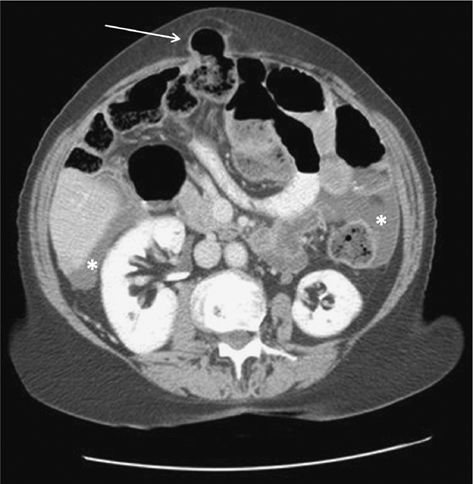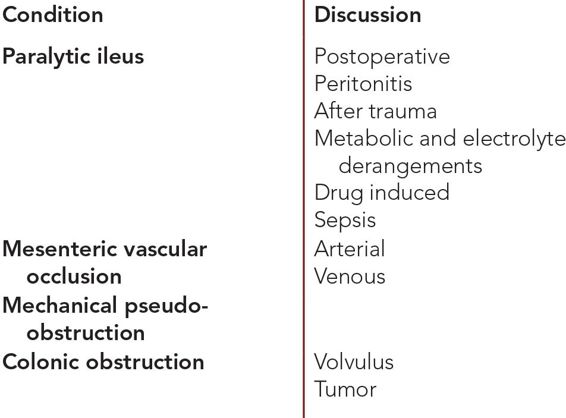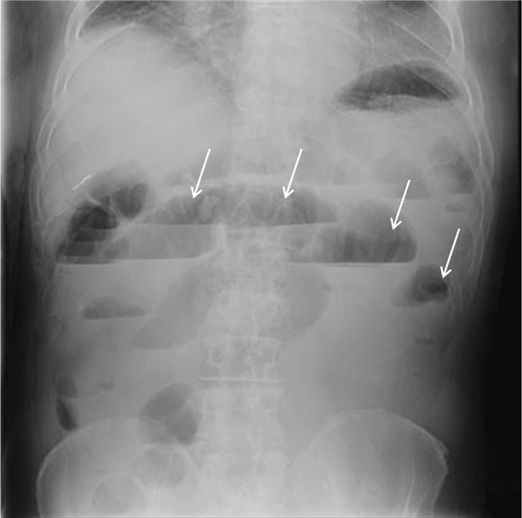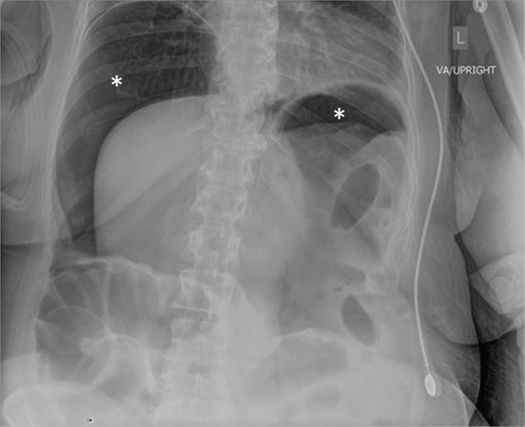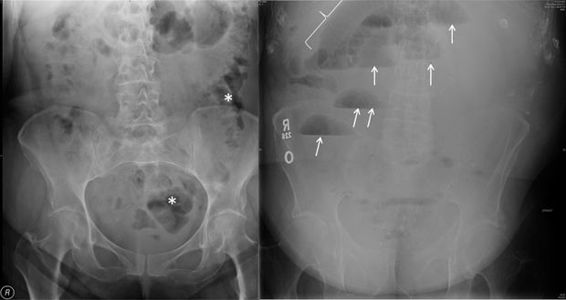SMALL-BOWEL OBSTRUCTION
CASE SCENARIO
A 62-year-old woman with worsening mid-abdominal pain, bloating, obstipation, nausea, and bilious vomiting presents to the emergency department. Her past surgical history is significant for a total abdominal hysterectomy 8 years ago. She is afebrile, but tachycardic to 110 bpm. Her abdomen is distended and tympanic to percussion, without rebound, guarding, or rigidity. There are hyperactive, tinkling bowel sounds with no external hernias. White blood cell count is 8000/uL.
EPIDEMIOLOGY
Small-bowel obstruction (SBO), or interruption of the flow of intestinal contents, is common, accounting for 12% to 16% of all surgical admissions.1,2 Over 300,000 operations are performed annually for SBO, and resultant costs exceed $2 billion each year in the United States.3
PATHOPHYSIOLOGY
The most common causes of SBO in the United States are adhesions (70%), followed by malignancy, inflammatory strictures, and incarcerated hernias. Other less common causes of SBO include congenital lesions, volvulus, intussusception, and gallstone ileus.4
When intestinal contents cannot pass normally, the bowel proximal to the site of obstruction becomes dilated, while contents distally are able to pass. Bacterial overgrowth occurs when intestinal contents become static, leading to increased distention, bowel wall edema, loss of absorptive function of the bowel, fluid sequestration, dehydration, and electrolyte abnormalities. In addition, fluid can be secreted into the bowel lumen, and transudative loss of fluid into the peritoneum can occur, worsening dehydration. Dehydration leads to decreased urine output, azotemia, hypotension, and tachycardia. Emesis contributes to electrolyte and acid loss, resulting in the classic hypokalemic, hypochloremic metabolic alkalosis. Strangulation occurs when intraluminal pressure exceeds perfusion pressure, causing ischemia and even necrosis of the bowel wall.
SBO can be classified as complete or partial. Most cases of strangulated bowel are in the setting of complete obstruction, but a Richter’s hernia (Figure 9–1) is a special case in which one wall of the bowel is strangulated, resulting in ischemia of a portion of the bowel without complete obstruction. As these patients do not present with clinically significant obstruction, diagnosis is often delayed, increasing morbidity. A “closed-loop” obstruction occurs when a portion of the bowel is twisted and thus consists of two points of obstruction. In these cases, the intestinal contents have no proximal or distal outlet. These obstructions are at high risk for progression to ischemia and necrosis.
Figure 9–1 Abdominal CT scan depicting a Richter’s hernia. The anterior wall of the colon protrudes through a ventral hernia defect (arrow). As the proximal colonic caliber is normal, there is no high-grade obstruction, but free fluid in the paracolic gutters (asterisks) raises concern for possible ischemia.
CLINICAL PRESENTATION
Presentation of SBO depends of the site of obstruction, whether the obstruction is partial or complete, and the vascular status of the bowel. More proximal obstructions lead to early symptoms of nausea and vomiting as well as abdominal pain, while distal obstructions present with obstipation, significant bloating, progressive distention of the bowel, and delayed onset of nausea and vomiting. Most patients with SBO have pain. More proximal obstructions are referred to the mid abdomen, while distal obstructions can present with lower abdominal pain. Crampy pain is common, while severe or continuous pain suggests strangulation or ischemia. In cases of ischemic necrosis, fever and leukocytosis are often present, along with severe abdominal pain and peritonitis. Mortality is greatly increased in cases of strangulation.5
Patients with closed-loop obstructions or volvulus often have little clinical evidence of obstruction (no vomiting and very little distention), but can rapidly progress to strangulation.
DIFFERENTIAL DIAGNOSIS
See Table 9–1.
WORKUP AND CHOICE OF IMAGING
Key priorities when evaluating a patient with SBO are to establish a definitive diagnosis (e.g., rule out ileus or colonic obstruction) to differentiate between partial and complete obstruction, to determine the cause of obstruction, and to assess the bowel for evidence of ischemia.
Plain abdominal radiographs (upright and supine abdominal x-ray) are less sensitive than computed tomography (CT).6 The overall sensitivity of plain films in SBO ranges from 59% to 93%,3 but ileus and large-bowel obstruction often cannot be differentiated.6 Films remain popular because of the low cost and availability and are sometimes used to follow progression of the disease.
CT scans can determine the location of SBO in 93% of cases and the cause in 80% to 91% of cases.3 In addition, CT is up to 100% specific in the evaluation of bowel ischemia.
Magnetic resonance imaging (MRI) has a sensitivity of 95%, a specificity of 100%, and can determine the site of obstruction in 73% of cases.3 It is limited by its cost and availability.
Ultrasound (US) has been shown to be as accurate as plain films in the diagnosis of SBO.7 Determination of the transition point can be made in most cases,6 and peritoneal fluid detected by ultrasound may suggest ischemia.8 While not widely used, US has the advantage of availability, affordability, and repeatability without radiation exposure, but is limited by its insensitivity in low-grade obstruction and the availability of expert technologists.
Contrast examination of the small bowel with plain films or fluoroscopy has been used with some success in cases of low-grade or partial obstructions that are difficult to detect on CT scan.3,6 In addition, water-soluble contrast studies can accurately predict the need for surgery,9 and the contrast material may shift fluid into the partially obstructed bowel, hastening return of bowel function and shortening hospital length of stay.10
IMAGING FINDINGS
 Plain Films
Plain Films
Classic findings in SBO include dilated loops of small intestine with colonic collapse. On upright films, there may be air-fluid levels, typically with a “stair step” appearance. Rarely, radiopaque foreign bodies are identified (e.g., gallstones). In some cases, free air under the diaphragm can indicate bowel perforation. In addition, bowel perforation can be suggested by the ability to delineate both the luminal surface and the serosa of bowel. The presence of air in the colon makes the diagnosis of complete obstruction less likely (Table 9–2 and Figures 9–2 through 9–4).
Figure 9–2 Upright abdominal x-ray with dilated small-bowel loops and air-fluid levels (arrows) in a stair-step pattern, indicative of small-bowel obstruction.
Figure 9–3 Upright chest x-ray demonstrating a large quantity of free air under the diaphragm (asterisks), indicative of bowel perforation.
Figure 9–4 Ileus vs SBO. The plain film on the left demonstrates ileus, with air in the colon (asterisks). In contrast, in the patient on the right with SBO, air-fluid levels (arrows) and dilated loops of bowel (bracket) are seen, as well as absence of air in the distal colon and rectum.
 CT Scan
CT Scan
Loops >2.5 to 3 cm in diameter are considered dilated. As with plain films, SBO on CT scan appears as dilated loops of small bowel with air-fluid levels and collapse of distal bowel. Proximal dilated loops become “fecalized” when static fluid becomes mixed with bacterial gas, and as an isolated finding predicts the need for hospitalization, the need for surgery, and 82% specificity for the diagnosis of SBO.11 A transition point can sometimes be seen, and adhesions are suggested by the absence of an intrinsic lesion at the point of narrowing. The anatomic position of dilated loops is altered, so the relative length of the dilated portion to the collapsed portion should be considered when attempting to localize the obstruction. Strangulation is suggested by wall thickness >3 mm, and by decreased, asymmetric, or delayed enhancement of the bowel wall with administration of intravenous contrast. A halo sign is a serrated, bead-like narrowing at the point of obstruction suggesting strangulation. Likewise, gas in the portal venous system is a grave sign associated with ischemic bowel. Haziness or obliteration of the mesenteric vessels is also a sign of potential ischemia, often accompanied by fluid or hemorrhage in the mesentery. A “whirl” sign is a swirl of rotated mesenteric vessels in the mesentery, consistent with volvulus (Table 9–3 and Figures 9–5 through 9–14).
